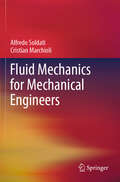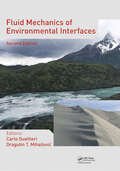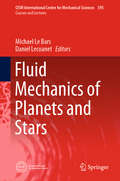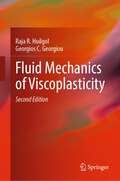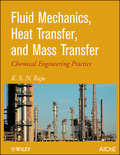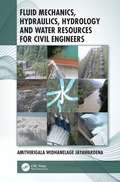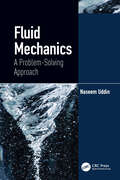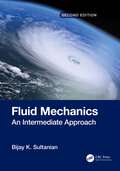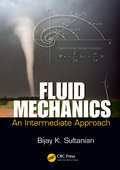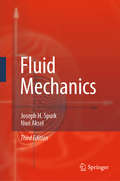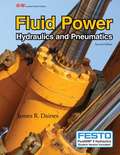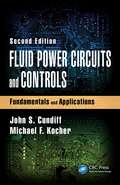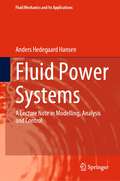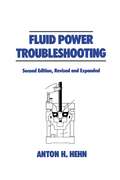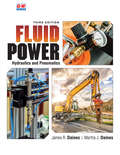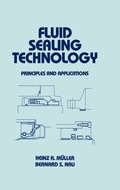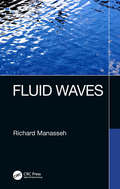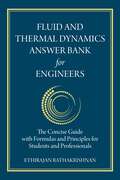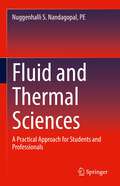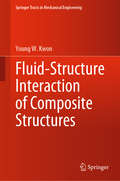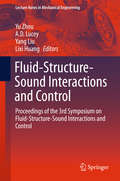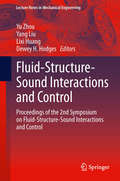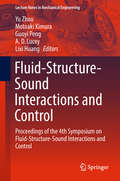- Table View
- List View
Fluid Mechanics for Mechanical Engineers
by Cristian Marchioli Alfredo SoldatiThis textbook describes the fundamentals of the phenomena of fluid dynamics in the context of engineering instances. It is designed to replace introductory books and notes on the subject for first-level engineering courses as well as higher-level courses or for professional use. The use of this book requires the basic knowledge of mathematics and physics normally delivered in the early years of undergraduate study. However, the extensive use of examples and solved exercises proposes a parallel intuitive route to understanding the necessary mathematical formalisms. It proves that a new fluid dynamics text should not contain new ideas or formalisms, but should present the material in a modern and intuitive way. The approach chosen is primarily practical, so that that readers can practice by solving the proposed problems and examples in order to be prepared to solve the new problems they will encounter in their academic and professional activities. It serves as a teaching tool for coursesin basic fluid dynamics, advanced fluid dynamics, turbulence, and aerodynamics.
Fluid Mechanics of Environmental Interfaces
by Sajjan G. ShivaEnvironmental Fluid Mechanics (EFM) studies the motion of air and water at several different scales, the fate and transport of species carried along by these fluids, and the interactions among those flows and geological, biological, and engineered systems. EFM emerged some decades ago as a response to the need for tools to study problems of flow an
Fluid Mechanics of Planets and Stars (CISM International Centre for Mechanical Sciences #595)
by Michael Le Bars Daniel LecoanetThis book explores the dynamics of planetary and stellar fluid layers, including atmospheres, oceans, iron cores, and convective and radiative zones in stars, describing the different theoretical, computational and experimental methods used to study these problems in fluid mechanics, including the advantages and limitations of each method for different problems. This scientific domain is by nature interdisciplinary and multi-method, but while much effort has been devoted to solving open questions within the various fields of mechanics, applied mathematics, physics, earth sciences and astrophysics, and while much progress has been made within each domain using theoretical, numerical and experimental approaches, cross-fertilizations have remained marginal. Going beyond the state of the art, the book provides readers with a global introduction and an up-to-date overview of relevant studies, fully addressing the wide range of disciplines and methods involved. The content builds on the CISM course “Fluid mechanics of planets and stars”, held in April 2018, which was part of the research project FLUDYCO, supported by the European Research Council (ERC) under the European Union's Horizon 2020 research and innovation program.
Fluid Mechanics of Viscoplasticity
by Raja R. Huilgol Georgios C. GeorgiouThis book considers the kinematics and dynamics of the flows of fluids exhibiting a yield stress. Continuum mechanics governing the fluid mechanics is described. Two chapters are dedicated to analytical solutions to several steady and unsteady flows of viscoplastic fluids, including flows with pressure-dependent rheological parameters. Perturbation methods, variational inequalities to solve fluid flow problems, and the use of energy methods are discussed. Numerical modeling using augmented Lagrangian, operator splitting, finite difference, and lattice Boltzmann methods are employed.The second edition provides new sections on flows of yield stress fluids with pressure-dependent rheological parameters, on flows with wall slip, and on deriving the fundamental equations for Boltzmann lattice materials. Furthermore new material on the lubrication approximation and applications of finite differences has been added.
Fluid Mechanics, Heat Transfer, and Mass Transfer: Chemical Engineering Practice
by K. S. RajuThis broad-based book covers the three major areas of Chemical Engineering. Most of the books in the market involve one of the individual areas, namely, Fluid Mechanics, Heat Transfer or Mass Transfer, rather than all the three. This book presents this material in a single source. This avoids the user having to refer to a number of books to obtain information. Most published books covering all the three areas in a single source emphasize theory rather than practical issues. This book is written with emphasis on practice with brief theoretical concepts in the form of questions and answers, not adopting stereo-typed question-answer approach practiced in certain books in the market, bridging the two areas of theory and practice with respect to the core areas of chemical engineering. Most parts of the book are easily understandable by those who are not experts in the field. Fluid Mechanics chapters include basics on non-Newtonian systems which, for instance find importance in polymer and food processing, flow through piping, flow measurement, pumps, mixing technology and fluidization and two phase flow. For example it covers types of pumps and valves, membranes and areas of their use, different equipment commonly used in chemical industry and their merits and drawbacks. Heat Transfer chapters cover the basics involved in conduction, convection and radiation, with emphasis on insulation, heat exchangers, evaporators, condensers, reboilers and fired heaters. Design methods, performance, operational issues and maintenance problems are highlighted. Topics such as heat pipes, heat pumps, heat tracing, steam traps, refrigeration, cooling of electronic devices, NOx control find place in the book. Mass transfer chapters cover basics such as diffusion, theories, analogies, mass transfer coefficients and mass transfer with chemical reaction, equipment such as tray and packed columns, column internals including structural packings, design, operational and installation issues, drums and separators are discussed in good detail. Absorption, distillation, extraction and leaching with applications and design methods, including emerging practices involving Divided Wall and Petluk column arrangements, multicomponent separations, supercritical solvent extraction find place in the book.
Fluid Mechanics, Hydraulics, Hydrology and Water Resources for Civil Engineers
by Amithirigala Widhanelage JayawardenaOne of the core areas of study in civil engineering concerns water that encompasses fluid mechanics, hydraulics and hydrology. Fluid mechanics provide the mathematical and scientific basis for hydraulics and hydrology that also have added empirical and practical contents. The knowledge contained in these three subjects is necessary for the optimal and equitable management of this precious resource that is not always available when and where it is needed, sometimes with conflicting demands. The objective of Fluid Mechanics, Hydraulics, Hydrology and Water Resources for Civil Engineers is to assimilate these core study areas into a single source of knowledge. The contents highlight the theory and applications supplemented with worked examples and also include comprehensive references for follow-up studies. The primary readership is civil engineering students who would normally go through these core subject areas sequentially spread over the duration of their studies. It is also a reference for practicing civil engineers in the water sector to refresh and update their skills.
Fluid Mechanics: A Problem-Solving Approach
by Naseem UddinFluid Mechanics: A Problem-Solving Approach provides a clear distinction between integral formulation and the different formulation of conservation law. Including a detailed discussion on pipe flow correlations, entrance length correlations, and plotting of Moody diagram, the book works through the comprehensive coverage of fluid mechanics with a gradual introduction of theory in a straightforward, practical approach. The book includes numerous end-of-chapter problems to enhance student understanding and different solving approaches. It features chapters on nanofluids, jets, waves in ocean and rivers, boundary layer separation, and Thwaites integral method, which are not typically covered in an introductory course. Features Provides a comprehensive treatment of fluid mechanics from the basic concepts to in-depth application problems. Covers waves and tsunamis. Offers two distinct chapters on jet flows and turbulent flows. Includes numerous end-of-chapter problems. Includes a Solutions Manual and MAPLE worksheets for instructor use. The book is intended for senior undergraduate mechanical and civil engineering students taking courses in fluid mechanics. The eBook+ version includes the following enhancements: 3 videos placed throughout the text to help apply real-world examples to concepts of Newtonian vs. Non-Newtonian fluids, vortices, and additional information on surface tension. Pop-up explanations of selected concepts as interactive flashcards in each chapter. Quizzes within chapters to help readers refresh their knowledge.
Fluid Mechanics: An Intermediate Approach
by Bijay K. SultanianFluid Mechanics: An Intermediate Approach helps readers develop a physics-based understanding of complex flows and mathematically model them with accurate boundary conditions for numerical predictions.The new edition starts with a chapter reviewing key undergraduate concepts in fluid mechanics and thermodynamics, introducing the generalized conservation equation for differential and integral analyses. It concludes with a self-study chapter on computational fluid dynamics (CFD) of turbulent flows, including physics-based postprocessing of 3D CFD results and entropy map generation for accurate interpretation and design applications. This book includes numerous worked examples and end-of-chapter problems for student practice. It also discusses how to numerically model compressible flow over all Mach numbers in a variable-area duct, accounting for friction, heat transfer, rotation, internal choking, and normal shock formation.This book is intended for graduate mechanical and aerospace engineering students taking courses in fluid mechanics and gas dynamics.Instructors will be able to utilize a solutions manual for their course.
Fluid Mechanics: An Intermediate Approach
by Bijay SultanianFluid Mechanics: An Intermediate Approach addresses the problems facing engineers today by taking on practical, rather than theoretical problems. Instead of following an approach that focuses on mathematics first, this book allows you to develop an intuitive physical understanding of various fluid flows, including internal compressible flows with s
Fluid Mechanics: Problems And Solutions
by Nuri Aksel Joseph H. SpurkThis successful textbook emphasizes the unified nature of all the disciplines of Fluid Mechanics as they emerge from the general principles of continuum mechanics. The different branches of Fluid Mechanics, always originating from simplifying assumptions, are developed according to the basic rule: from the general to the specific. The first part of the book contains a concise but readable introduction into kinematics and the formulation of the laws of mechanics and thermodynamics. The second part consists of the methodical application of these principles to technology. In addition, sections about thin-film flow and flow through porous media are included.
Fluid Power (Second Edition): Hydraulics and Pneumatic
by James R. DainesFluid Power: Hydraulics and Pneumaticsis a teaching package aimed at students pursuing a technician-level career path. It teaches the fundamentals of fluid power and provides details on the design and operation of hydraulic and pneumatic components, circuits, and systems. Extensive coverage is provided for both hydraulic and pneumatic systems. This book does not contain engineering calculations that will confuse students. Instead, it applies math skills to the formulas needed by the technician-level student. Full-color illustrations throughout the text. Each chapter includes detailed Internet resources related to the chapter topics to allow further exploration. Laboratory manual contains activities correlated to the chapter topic, and chapter quizzes to measure student knowledge. Bundled with the textbook is the student version of FluidSIM Hydraulics simulation software. This popular software from Festo Didactic allows circuits to be designed and simulated on the computer. The software can be used to provide additional activities of your own design.
Fluid Power Circuits and Controls: Fundamentals and Applications, Second Edition
by John S. Cundiff Michael F. KocherFluid Power Circuits and Controls: Fundamentals and Applications, Second Edition, is designed for a first course in fluid power for undergraduate engineering students. After an introduction to the design and function of components, students apply what they’ve learned and consider how the component operating characteristics interact with the rest of the circuit. The Second Edition offers many new worked examples and additional exercises and problems in each chapter. Half of these new problems involve the basic analysis of specific elements, and the rest are design-oriented, emphasizing the analysis of system performance. The envisioned course does not require a controls course as a prerequisite; however, it does lay a foundation for understanding the extraordinary productivity and accuracy that can be achieved when control engineers and fluid power engineers work as a team on a fluid power design problem. A complete solutions manual is available for qualified adopting instructors.
Fluid Power Maintenance Basics and Troubleshooting
by Richard J. Mitchell John J. PippengerThis unique single-source reference-the first book of its kind to address systematically the problems involved in the field-offers comprehensive coverage of hydraulic system troubleshooting and encourages change in the trial-and-error methods common in rectifying problems and restoring system downtime, furnishing a new paradigm for troubleshooting
Fluid Power Systems: A Lecture Note in Modelling, Analysis and Control (Fluid Mechanics and Its Applications #129)
by Anders Hedegaard HansenThis book covers some of the fundamental topics in fluid power technology, presenting detailed derivations of formulas that form the basis of the theory. It shows the reader how to properly (i) design basic fluid power systems, (ii) construct lumped parameter models of simple fluid power systems, (iii) perform frequency analysis of fluid power components and systems, and (iv) develop controllers for fluid power systems. The book mainly focusses on mathematical modelling and analysis of fluid power components and systems i.e. practical issues such as working principles and construction of components are not covered in depth. The text is organized in four main parts: I Physics of Fluid, II Fluid Power Components, III Fluid Power Systems and IV Learning by Doing.
Fluid Power Troubleshooting, Second Edition,
by Anton HehnPresents practical methods for detecting, diagnosing and correcting fluid power problems within a system. The work details the design, maintenance, and troubleshooting of pneumatic, hydraulic and electrical systems and components. This second edition stresses: developments in understanding the complex interactions of components within a fluid power system; cartridge valve systems, proportional valve and servo-systems, and compressed air drying and filtering; noise reduction and other environmental concerns; and more.;This work should be of interest to mechanical, maintenance, manufacturing, system and machine design, hydraulic, pneumatic, industrial, chemical, electrical and electronics, lubrication, plastics processing, automotive, process control, and power system engineers; manufacturers of hydraulic and pneumatic machinery; systems maintenance personnel; and upper-level undergraduate and graduate students in these disciplines.
Fluid Power: Hydraulics And Pneumatics
by James R. Daines Martha J. DainesFluid Power: Hydraulics and Pneumatics is an introductory text targeted to students pursuing a technician-level career path. It presents the fundamentals of this subject with extensive coverage of both hydraulic and pneumatic systems. Coverage includes details on the design and operation of hydraulic and pneumatic components, circuits, and systems.
Fluid Sealing Technology: Principles and Applications
by Heinz K Muller"Assists users, developers, researchers, and manufacturers in the design, selection, development, and application of seals and sealing systems for fluids."
Fluid Waves
by Richard ManassehThe book derives the mathematical basis for the most encountered waves in science and engineering. It gives the basis to undertake calculations required for important occupations such as maritime engineering, climate science, urban noise control, and medical diagnostics. The book initiates with fluid dynamics basis with subsequent chapters covering surface gravity waves, sound waves, internal gravity waves and waves in rotating fluids, and details basic phenomena such as refraction. Thereafter, specialized application chapters include description of specific contemporary problems. All concepts are supported by narrative examples, illustrations, and case studies. Features:- Explains the basis of wave mechanics in fluid systems. Provides tools for the analysis of water waves, sound waves, internal gravity, and rotating fluid waves through different examples. Includes comprehensible mathematical derivations at the expense of fewer theoretical topics. Reviews cases describable by linear theory and cases requiring nonlinear and wave-interaction theories. Supports concepts with narrative examples, illustrations, and case studies. This book aims at Senior Undergraduates/Graduate students and Researchers in Fluid Mechanics, Applied Mathematics, Mechanical Engineering, Civil Engineering, and Physical Oceanography.
Fluid and Thermal Dynamics Answer Bank for Engineers: The Concise Guide with Formulas and Principles for Students and Professionals
by Ethirajan RathakrishnanThis book provides the essence of aerodynamics, fluid mechanics, experimental methods, gas dynamics, high enthalpy gas dynamics, helicopter aerodynamics, heat transfer, and thermodynamics, describing the underlying principles of these subjects before list
Fluid and Thermal Sciences: A Practical Approach for Students and Professionals
by Nuggenhalli S. Nandagopal, PEThis text provides a clear understanding of the fundamental principles of thermal and fluid sciences in a concise manner in a rigorous yet easy to follow language and presentation. Elucidation of the principles is further reinforced by examples and practice problems with detailed solutions. Firmly grounded in the fundamentals, the book maximizes readers’ capacity to take on new problems and challenges in the field of fluid and thermal sciences with confidence and conviction. Standing also as a ready reference and review of the essential theories and their applications in fluid and thermal sciences, the book is applicable for undergraduate mechanical and chemical engineering students, students in engineering technology programs, as well as practicing engineers preparing for the engineering license exams (FE and PE) in USA and abroad.Explains the concepts and theory with a practical approach that readers can easily absorb;Provides the just the right amount of theoretical and mathematical background needed, making it less intimidating for the reader;Covers fluid and thermal sciences in a straight-forward yet comprehensive manner facilitating a good understanding of the subject matter;Includes a wide spectrum and variety of problems along with numerous illustrative solved examples and many practice problems with solutions.
Fluid-Induced Seismicity
by Serge A. ShapiroThe characterisation of fluid transport properties of rocks is one of the most important, yet difficult, challenges of reservoir geophysics, but is essential for optimal development of hydrocarbon and geothermal reservoirs. This book provides a quantitative introduction to the underlying physics, application, interpretation, and hazard aspects of fluid-induced seismicity with a particular focus on its spatio-temporal dynamics. It presents many real data examples of microseismic monitoring of hydraulic fracturing at hydrocarbon fields and of stimulations of enhanced geothermal systems. The author also covers introductory aspects of linear elasticity and poroelasticity theory, as well as elements of seismic rock physics and mechanics of earthquakes, enabling readers to develop a comprehensive understanding of the field. Fluid-Induced Seismicity is a valuable reference for researchers and graduate students working in the fields of geophysics, geology, geomechanics and petrophysics, and a practical guide for petroleum geoscientists and engineers working in the energy industry.
Fluid-Structure Interaction of Composite Structures (Springer Tracts in Mechanical Engineering)
by Young W. KwonThis is the first book presenting dynamic responses and failure of polymer composite structures as they interact with internal and/or external fluid media. It summarizes authoritative research carried out by the author in the past decade on various aspects of Fluid-Structure Interaction (FSI) to present important effects of FSI on composite structures. The topics include impact loading on composite structures with air-back, water-back, or containing water; FSI effects on frequencies, mode shapes, and modal curvatures; cyclic loading for fatigue failure with FSI; coupling of independent composite structures by fluid media; and moving composite structures in water. Numerical techniques for FSI are also presented. Research was conducted both experimentally and numerically to complement each other. The book offers a timely, comprehensive information to fluid-structure interaction of composite structures for students, researchers or practicing engineers.
Fluid-Structure-Sound Interactions and Control
by Yang Liu Yu Zhou Lixi Huang A. D. LuceyTheseproceedings primarily focus on advances in the theory, experiments, andnumerical simulations of turbulence in the contexts of flow-induced vibrationand noise, as well as their control. Fluid-related structural vibration andnoise problems are often encountered in many engineering fields, increasinglymaking them a cause for concern. The FSSIC conference, held on 5-9 July 2015 inPerth, featured prominent keynote speakers such as John Kim, Nigel Peake, SongFu and Colin Hansen, as well as talks on a broad range of topics: turbulence,fluid-structure interaction, fluid-related noise and the control/managementaspects of these research areas, many of which are clearly interdisciplinary innature. It provided a forum for academics, scientists and engineers working inall branches of Fluid-Structure-Sound Interactions and Control (FSSIC) toexchange and share the latest developments, ideas and advances, bringing themtogether researchers from East and West to push forward the frontiers of FSSIC,ensuring that the proceedings will be of interest to a broad engineeringcommunity.
Fluid-Structure-Sound Interactions and Control
by Dewey H. Hodges Yang Liu Yu Zhou Lixi HuangWith rapid economic and industrial development in China, India and elsewhere, fluid-related structural vibration and noise problems are widely encountered in many fields, just as they are in the more developed parts of the world, causing increasingly grievous concerns. Turbulence clearly has a significant impact on many such problems. On the other hand, new opportunities are emerging with the advent of various new technologies, such as signal processing, flow visualization and diagnostics, new functional materials, sensors and actuators, etc. These have revitalized interdisciplinary research activities, and it is in this context that the 2nd symposium on fluid-structure-sound interactions and control (FSSIC) was organized. Held in Hong Kong (May 20-21, 2013) and Macau (May 22-23, 2013), the meeting brought together scientists and engineers working in all related branches from both East and West and provided them with a forum to exchange and share the latest progress, ideas and advances and to chart the frontiers of FSSIC. The Proceedings of the 2nd Symposium on Fluid-Structure-Sound Interactions and Control largely focuses on advances in the theory, experimental research and numerical simulations of turbulence in the contexts of flow-induced vibration, noise and their control. This includes several practical areas for interaction, such as the aerodynamics of road and space vehicles, marine and civil engineering, nuclear reactors and biomedical science etc. One of the particular features of these proceedings is that it integrates acoustics with the study of flow-induced vibration, which is not a common practice but is scientifically very helpful in understanding, simulating and controlling vibration. This offers a broader view of the discipline from which readers will benefit greatly. These proceedings are intended for academics, research scientists, design engineers and graduate students in engineering fluid dynamics, acoustics, fluid and aerodynamics, vibration, dynamical systems and control etc. Yu Zhou is a professor in Institute for Turbulence-Noise-Vibration Interaction and Control at Harbin Institute of Technology. Yang Liu is an associate professor at The Hong Kong Polytechnic University. Lixi Huang, associate professor, works at the University of Hong Kong. Professor Dewey H. Hodges works at the School of Aerospace Engineering, Georgia Institute of Technology.
Fluid-Structure-Sound Interactions and Control: Proceedings Of The 2nd Symposium On Fluid-structure-sound Interactions And Control (Lecture Notes In Mechanical Engineering)
by Yu Zhou Lixi Huang A. D. Lucey Motoaki Kimura Guoyi PengThis book presents the proceedings of the Symposium on Fluid-Structure-Sound Interactions and Control (FSSIC), (held in Tokyo on Aug. 21-24, 2017), which largely focused on advances in the theory, experiments on, and numerical simulation of turbulence in the contexts of flow-induced vibration, noise and their control. This includes several practical areas of application, such as the aerodynamics of road and space vehicles, marine and civil engineering, nuclear reactors and biomedical science, etc. Uniquely, these proceedings integrate acoustics with the study of flow-induced vibration, which is not a common practice but can be extremely beneficial to understanding, simulating and controlling vibration. The symposium provides a vital forum where academics, scientists and engineers working in all related branches can exchange and share their latest findings, ideas and innovations – bringing together researchers from both east and west to chart the frontiers of FSSIC.
